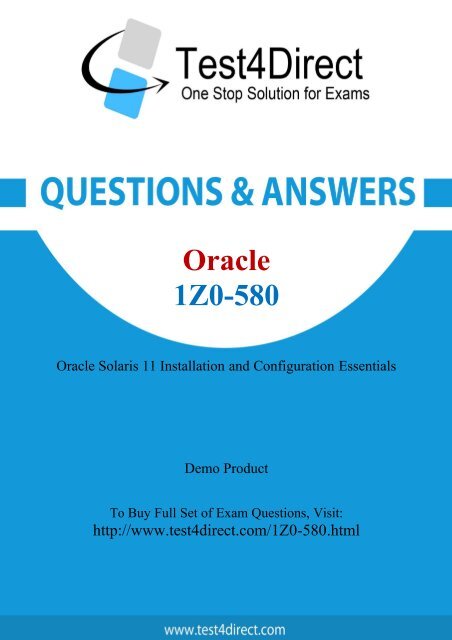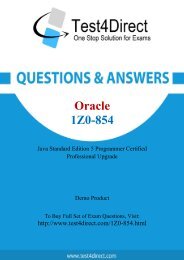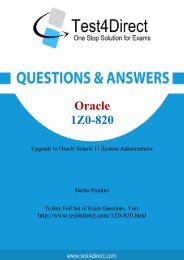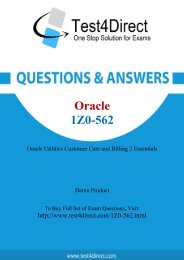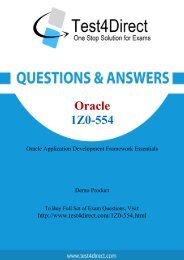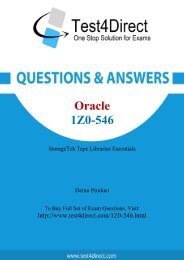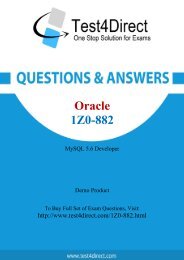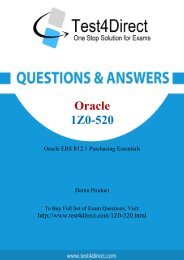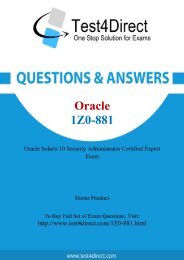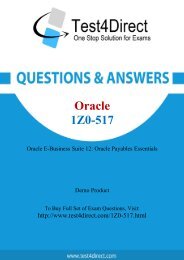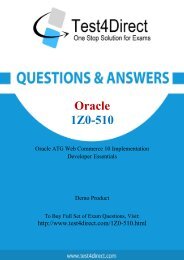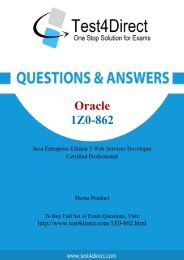Buy 1Z0-580 BrainDumps and Get Discount
Test4Direct provides latest PDF questions of Oracle 1Z0-580 exam. You have an opportunity to pass the Oracle 1Z0-580 exam in one go. Test4Direct is most accurate source to prepare Oracle 1Z0-580 exam as your success will become site’s responsibility after purchasing 1Z0-580 exam product. There are also lots of discounts and promotion offers that you can avail. Let’s try a free demo http://www.test4direct.com/1Z0-580.html
Test4Direct provides latest PDF questions of Oracle 1Z0-580 exam. You have an opportunity to pass the Oracle 1Z0-580 exam in one go. Test4Direct is most accurate source to prepare Oracle 1Z0-580 exam as your success will become site’s responsibility after purchasing 1Z0-580 exam product. There are also lots of discounts and promotion offers that you can avail. Let’s try a free demo http://www.test4direct.com/1Z0-580.html
Create successful ePaper yourself
Turn your PDF publications into a flip-book with our unique Google optimized e-Paper software.
Oracle<br />
<strong>1Z0</strong>-<strong>580</strong><br />
Oracle Solaris 11 Installation <strong>and</strong> Configuration Essentials<br />
Demo Product<br />
To <strong>Buy</strong> Full Set of Exam Questions, Visit:<br />
http://www.test4direct.com/<strong>1Z0</strong>-<strong>580</strong>.html
Question: 1<br />
What information would the "beadm list -ds" comm<strong>and</strong> output?<br />
A. a list of all Bes<br />
B. a list of the datasets <strong>and</strong> snapshot information for the active BE<br />
C. a list of the datasets <strong>and</strong> snapshot information for all Bes<br />
D. a list of the default sets<br />
E. a list of BEs in machine readable format<br />
Question: 2<br />
Answer: C<br />
Explanation:<br />
You can display information about snapshots, boot environments, <strong>and</strong> datasets that were created by<br />
the beadm comm<strong>and</strong> by using the beadm list subcomm<strong>and</strong>. The beadm list comm<strong>and</strong> output also<br />
displays boot environments that are created by the pkg comm<strong>and</strong>.<br />
The beadm list comm<strong>and</strong> syntax is:<br />
Syntax: beadm list [-a | [-ds] [-H] [BeName]<br />
The comm<strong>and</strong> lists information about the existing boot environment. To view information for a<br />
specific boot environment, replace BeName with a boot environment name. If a specific boot<br />
environment is not specified, the comm<strong>and</strong> lists information about all boot environments. The<br />
default is to list boot environments without additional information.<br />
-a – Lists all available information about the boot environment. This information includes<br />
subordinate datasets <strong>and</strong> snapshots.<br />
-d – Lists information about all subordinate datasets that belong to the boot environment.<br />
-s – Lists information about the snapshots of the boot environment.<br />
-H – Prevents listing header information. Each field in the output is separated by a semicolon.<br />
Reference: Oracle Solaris 11 Information Library, Listing Existing Boot Environments <strong>and</strong> Snapshots<br />
What two entries could complete the following comm<strong>and</strong> from the directory listing below?<br />
A. inetboot.SUN4U.Solaris_10-1<br />
B. inetboot.SUN4V.Solaris_l0-1<br />
C. nbp.<br />
D. pxegrub.I86PC.Solaris_10-1<br />
E. sllgrub.i86pc
Question: 3<br />
Answer: D, E<br />
Explanation:<br />
As per exhibit these are the two files in the netboot directory.<br />
Note:<br />
*Missing argument is:<br />
file=wanbootCGI-URL<br />
Specifies the URL of the wanboot-cgi program on the web server<br />
* During the installation, WAN boot refers to the contents of the /etc/netboot hierarchy on the web<br />
server for instructions about how to perform the installation. This directory contains the<br />
configuration information, private key, digital certificate, <strong>and</strong> certificate authority required for a WAN<br />
boot installation. During the installation, the wanboot-cgi program converts this information into the<br />
WAN boot file system. The wanboot-cgi program then transmits the WAN boot file system to the<br />
client.<br />
A developer wants to use DTrace in a zone to examine the kernel. What are his options?<br />
A. Modify the zone so that he can use DTrace to examine kennel data structures.<br />
B. All that’s required is to assume the "root" role.<br />
C. By using dtrace_proc <strong>and</strong> dtrace_user privileges he can examine his own code, but not the kernel.<br />
D. By adding ipc_dac_read <strong>and</strong> ipc_dac_write privileges to the zone.<br />
E. Change the zone's file-mac-profile from strict to none to enable the use of DTrace within the zone.<br />
Answer: C<br />
Explanation:<br />
How to Use DTrace in a Non-global Zone<br />
1. Use the zonecfg limitpriv property to add the dtrace_proc <strong>and</strong> dtrace_user privileges.<br />
global# zonecfg -z my-zone<br />
zonecfg:my-zone> set limitpriv="default,dtrace_proc,dtrace_user"<br />
zonecfg:my-zone> exit<br />
Note –<br />
Depending on your requirements, you can add either privilege, or both privileges.<br />
2. Boot the zone.<br />
3. global# zoneadm -z my-zone boot<br />
Log in to the zone.<br />
global# zlogin my-zone<br />
4. Run the DTrace program.<br />
my-zone# dtrace -l<br />
Note:<br />
* Oracle Solaris DTrace is a comprehensive, advanced tracing tool for troubleshooting systemic<br />
problems in real time.<br />
* DTrace helps you underst<strong>and</strong> a software system by enabling you to dynamically modify the<br />
operating system kernel <strong>and</strong> user processes to record additional data that you specify at locations of<br />
interest, called probes.<br />
Reference: System Administration Guide: Oracle Solaris Containers-Resource Management <strong>and</strong><br />
Oracle Solaris Zones, Using DTrace in a Non-Global Zone
Question: 4<br />
Your system has two disk devices, c2t0d0 <strong>and</strong> c2t1d0, <strong>and</strong> two flash devices, c2t5d0 <strong>and</strong> c2t8d0.<br />
Which comm<strong>and</strong> would you to create a storage pool named “tank,” which mirrors the disks <strong>and</strong> adds<br />
the two flash devices as “cache”?<br />
A. zpool create tank mirror c2t0d0 c2t1d0 mirror c2t5d0 c2t8d0<br />
B. zpool create tank mirror c2t0d0 c2t1d0 log mirror c2t5d0 c2t8d0<br />
C. zpool c2t0d0 c2t1d0 cache c2t5d0 c2t8d0 mirror<br />
D. zpool create tank mirror c2t0d0 c2t1d0 cache c2t5d0 c2t8d0<br />
E. zpool create tank raidz2 c2t0d0 c2t1d0 c2t5d0 c2t8d0<br />
Answer: D<br />
Explanation:<br />
Creating a ZFS Storage Pool with Cache Devices<br />
You can create a storage pool with cache devices to cache storage pool data. For example:<br />
# zpool create tank mirror c2t0d0 c2t1d0 c2t3d0 cache c2t5d0 c2t8d0<br />
Note:<br />
* Creating a Basic Storage Pool<br />
The following comm<strong>and</strong> creates a new pool named tank that consists of the disks c1t0d0 <strong>and</strong> c1t1d0:<br />
# zpool create tank c1t0d0 c1t1d0<br />
These whole disks are found in the /dev/dsk directory <strong>and</strong> are labelled appropriately by ZFS to<br />
contain a single, large slice. Data is dynamically striped across both disks.<br />
* Creating a Mirrored Storage Pool<br />
To create a mirrored pool, use the mirror keyword, followed by any number of storage devices that<br />
will comprise the mirror. Multiple mirrors can be specified by repeating the mirror keyword on the<br />
comm<strong>and</strong> line. The following comm<strong>and</strong> creates a pool with two, two-way mirrors:<br />
# zpool create tank mirror c1d0 c2d0 mirror c3d0 c4d0<br />
Reference: Solaris ZFS Administration Guide, Creating a ZFS Storage Pool with Cache Devices<br />
Question: 5<br />
The "pkg update" comm<strong>and</strong> will ______.<br />
A. update all packages that have updates available including the kernel
B. update all packages that have updates available excluding the kernel<br />
C. update only the kernel image<br />
D. update the global zone packages <strong>and</strong> non-global zone packages<br />
E. update all packages <strong>and</strong> the kernel, <strong>and</strong> then automatically reboot the system<br />
Question: 6<br />
Question: 7<br />
Answer: A<br />
Explanation:<br />
Updating all of the packages on your installed system – To update all of the packages on your system<br />
that have available updates, use the pkg update comm<strong>and</strong>, as follows:<br />
# pkg update<br />
Running this comm<strong>and</strong> updates packages that you might not otherwise consider updating, for<br />
example, kernel components <strong>and</strong> other low-level system packages.<br />
What three items are true with regard to network planning in a Solaris 11 environment?<br />
A. Hardware <strong>and</strong> network topology should be planned in advance of installation.<br />
B. Subnetting needs to be considered when implementing IPv6 networks.<br />
C. IPv4 <strong>and</strong> IPv6 network addressing cannot co-exist on the same server.<br />
D. Solaris 11 enables the use of local files, NIS, DNS, or LDAP for name services.<br />
E. The physical network topology will determine if you need routers, not all networks require<br />
routers.<br />
Answer: A, C, D<br />
Explanation:<br />
The following table lists different tasks for planning the network configuration.<br />
* (A) Identify the hardware requirements of your planned network topology.<br />
Determine the types of equipment that you need for your network site.<br />
*(C) Determine the type of IP addresses to use <strong>and</strong> obtain registered IP addresses.<br />
Select whether you are deploying a purely IPv4 network, an IPv6 network, or a network that uses<br />
both types of IP addresses. Obtain unique IP addresses to communicate to public networks in the<br />
Internet.<br />
* (D) Determine a naming scheme to identify the hosts in the network as well as the name service to<br />
use.<br />
Create a list of names to assign to the systems on the network <strong>and</strong> decide whether to use NIS, LDAP,<br />
DNS, or the network databases in the local /etc directory.<br />
* If necessary, establish administrative subdivisions <strong>and</strong> design a strategy for subnets.<br />
Decide if your site requires that you divide your network into subnets to service administrative<br />
subdivisions<br />
* Determine where to place routers in the network design.<br />
If your network is large enough to require routers, create a network topology that supports them.<br />
* Decide whether to create virtual networks in the overall network configuration scheme.<br />
You might need to create virtual networks within a system to reduce the hardware footprint of your<br />
network.<br />
Reference: Oracle Solaris 11 Information Library, Network Planning (Task Map)
To upgrade a system from Oracle Solaris 10 to Oracle Solaris 11, it is necessary to________.<br />
A. convert all Oracle Solaris 10 packages to Oracle Solaris 11 packages using IPS<br />
B. use IPS <strong>and</strong> Live Upgrade to install all updated software<br />
C. use IPS to replace the Oracle Solaris 10 kernel with the Oracle Solaris 11 kernel<br />
D. save user data <strong>and</strong> perform a new Oracle Solaris 11 install; there is no upgrade method<br />
E. update Oracle Solaris 10 from an Oracle Solaris 11 repository<br />
Answer: D<br />
Explanation:<br />
There are no upgrade methods or tools available to transition from Oracle Solaris 10 to Oracle Solaris<br />
11. You cannot use an installer to upgrade from Oracle Solaris 10 to Oracle Solaris 11.<br />
Oracle Solaris 11 Transition Tools <strong>and</strong> Features<br />
Note:<br />
* There are no upgrade methods or tools available to transition from Oracle Solaris 10 to Oracle<br />
Solaris 11. You cannot use an installer to upgrade from Oracle Solaris 10 to Oracle Solaris 11.<br />
/ JumpStart Migration Utility (js2ai)<br />
Used to convert Oracle Solaris 10 JumpStart rules <strong>and</strong> profiles to a format that is compatible with AI<br />
manifest entries.<br />
/ ZFS shadow migration feature<br />
Used to migrate data from an existing file system to a new file system.<br />
/ Oracle Solaris 11 support for Oracle Solaris 10 zones<br />
Used to migrate your Oracle Solaris 10 application environments to an Oracle Solaris 11 system.<br />
/ NFS file sharing <strong>and</strong> pool migration<br />
Used to access shared files from an Oracle Solaris 10 system on an Oracle Solaris 11 system.<br />
Used to import a ZFS storage pool from an Oracle Solaris 10 system into an Oracle Solaris 11 system.<br />
Reference: Oracle Solaris 11 Information Library, Transitioning Your Oracle Solaris 10 System to<br />
Oracle Solaris 11
THANKS FOR TRYING THE DEMO OF OUR PRODUCT<br />
Visit Our Site to Purchase the Full Set of Actual <strong>1Z0</strong>-<strong>580</strong> Exam Questions With Answers.<br />
http://www.test4direct.com/<strong>1Z0</strong>-<strong>580</strong>.html<br />
We Also Provide Practice Exam Software That Simulates Real Exam Environment And Has<br />
Many Self-Assessment Features. Download Free Product Demo From:<br />
http://www.test4direct.com/<strong>1Z0</strong>-<strong>580</strong>.html<br />
Money Back Guarantee<br />
Check Out Our Customer Testimonials


